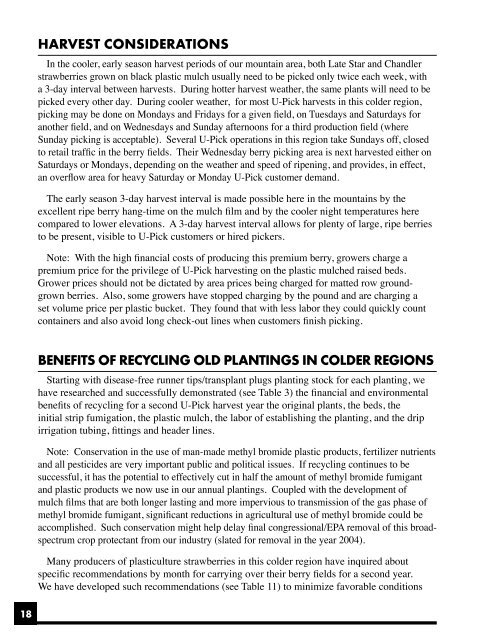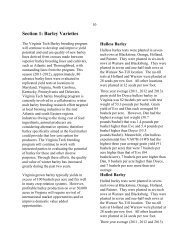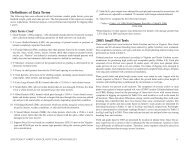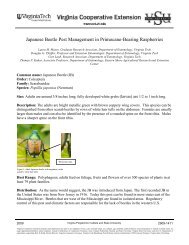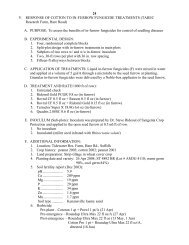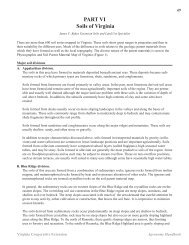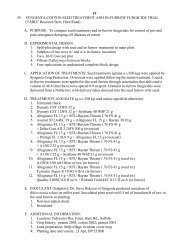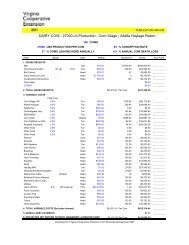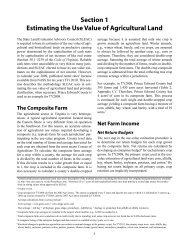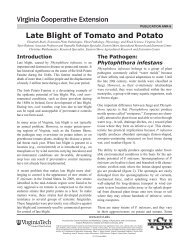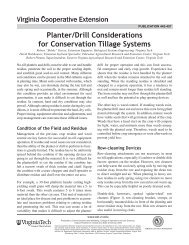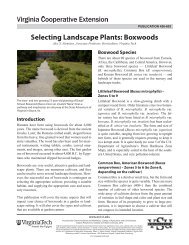PDF (1 MB) - Virginia Cooperative Extension - Virginia Tech
PDF (1 MB) - Virginia Cooperative Extension - Virginia Tech
PDF (1 MB) - Virginia Cooperative Extension - Virginia Tech
You also want an ePaper? Increase the reach of your titles
YUMPU automatically turns print PDFs into web optimized ePapers that Google loves.
HARVEST CONSIDERATIONS<br />
In the cooler, early season harvest periods of our mountain area, both Late Star and Chandler<br />
strawberries grown on black plastic mulch usually need to be picked only twice each week, with<br />
a 3-day interval between harvests. During hotter harvest weather, the same plants will need to be<br />
picked every other day. During cooler weather, for most U-Pick harvests in this colder region,<br />
picking may be done on Mondays and Fridays for a given field, on Tuesdays and Saturdays for<br />
another field, and on Wednesdays and Sunday afternoons for a third production field (where<br />
Sunday picking is acceptable). Several U-Pick operations in this region take Sundays off, closed<br />
to retail traffic in the berry fields. Their Wednesday berry picking area is next harvested either on<br />
Saturdays or Mondays, depending on the weather and speed of ripening, and provides, in effect,<br />
an overflow area for heavy Saturday or Monday U-Pick customer demand.<br />
The early season 3-day harvest interval is made possible here in the mountains by the<br />
excellent ripe berry hang-time on the mulch film and by the cooler night temperatures here<br />
compared to lower elevations. A 3-day harvest interval allows for plenty of large, ripe berries<br />
to be present, visible to U-Pick customers or hired pickers.<br />
Note: With the high financial costs of producing this premium berry, growers charge a<br />
premium price for the privilege of U-Pick harvesting on the plastic mulched raised beds.<br />
Grower prices should not be dictated by area prices being charged for matted row groundgrown<br />
berries. Also, some growers have stopped charging by the pound and are charging a<br />
set volume price per plastic bucket. They found that with less labor they could quickly count<br />
containers and also avoid long check-out lines when customers finish picking.<br />
BENEFITS OF RECYCLING OLD PLANTINGS IN COLDER REGIONS<br />
Starting with disease-free runner tips/transplant plugs planting stock for each planting, we<br />
have researched and successfully demonstrated (see Table 3) the financial and environmental<br />
benefits of recycling for a second U-Pick harvest year the original plants, the beds, the<br />
initial strip fumigation, the plastic mulch, the labor of establishing the planting, and the drip<br />
irrigation tubing, fittings and header lines.<br />
Note: Conservation in the use of man-made methyl bromide plastic products, fertilizer nutrients<br />
and all pesticides are very important public and political issues. If recycling continues to be<br />
successful, it has the potential to effectively cut in half the amount of methyl bromide fumigant<br />
and plastic products we now use in our annual plantings. Coupled with the development of<br />
mulch films that are both longer lasting and more impervious to transmission of the gas phase of<br />
methyl bromide fumigant, significant reductions in agricultural use of methyl bromide could be<br />
accomplished. Such conservation might help delay final congressional/EPA removal of this broadspectrum<br />
crop protectant from our industry (slated for removal in the year 2004).<br />
Many producers of plasticulture strawberries in this colder region have inquired about<br />
specific recommendations by month for carrying over their berry fields for a second year.<br />
We have developed such recommendations (see Table 11) to minimize favorable conditions<br />
18


